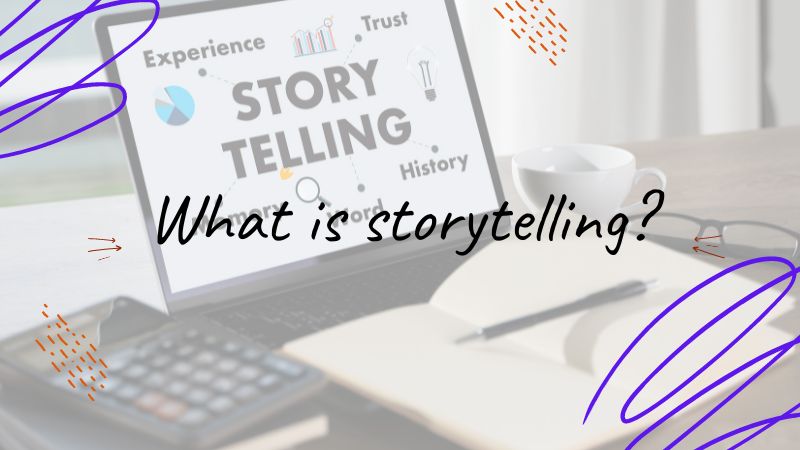Once upon a time in a faraway kingdom, there lived storytellers: film and television directors, marketers, PR specialists, social media managers, and Instagram bloggers. They possessed the magical power of gathering huge crowds of people around their campfires and screens and telling them stories.
The stories were completely different: some revealed their personal problems, sharing dramas of everyday life and difficulties of building relationships; others talked about a new product and its advantages; some made their cats and dogs dance or run into flat, transparent surfaces of their front doors to entertain their audience. And more sophisticated storytellers came up with terrifying horror stories about bloodthirsty clowns and machines that wanted to take over the world.
The gift possessed by these creators and orators is called storytelling. You can also learn this magical art if you plan to become a famous blogger, cool social media specialist, or a film director.
In simple terms, storytelling is the art of narration in which the storyteller conveys information to their audience in an entertaining format, taking into account the dramatic structure: a certain plotline, conflict, and resolution.
A story is capable of turning listeners into participants of the events, transporting them to the storyteller's world, crossing the threshold of intimacy and being in the moment where all emotions and impressions are real. Moreover, information is better absorbed if its delivery is associated with emotional perception: empathy and sympathy. The effect becomes stronger if the listener has experienced something similar in the past or if it is currently present in their life. This is why we watch movies and become attached to bloggers' stories - all the stories they tell us are directly or indirectly related to our inner world.
Today, storytelling is perhaps the most effective method of turning a boring topic into an exciting text or video, and is therefore widely used in marketing. A well-constructed story can be much more convincing for the reader than just arguments and facts.
Storytelling helps businesses establish a trusting relationship with potential customers and sell more. Rob Walker (writer, journalist) and Joshua Glenn (writer, semiotic analyst) demonstrated the value of storytelling in marketing in their joint book "Selling Stories!" They purchased trinkets such as buttons, bottle openers, and various figurines from thrift stores for just a few dollars each and put them up for auction on eBay, accompanied by a heartfelt story for each item. They spent only $200, but skilled storytellers earned almost $8,000. This experiment showed that proper storytelling can increase the subjective value of any useless item and increase the profitability of investments.
Storytelling in business starts with a slogan. For example, "Just do it" is a ready-made call to action, aimed at achieving the goal and purchasing products of the Nike company. The task of the slogan is to demonstrate the brand's values and its basic principles. Thanks to the slogan, consumers should understand how emotionally close the product is to them.
A website can also be created in the format of storytelling and filled with life through real customer stories, for example, writing about how your products and services help people solve certain life tasks.
Email newsletters can bring in new customers and maintain the loyalty of those who have already purchased something from you. However, the information must be presented in an interesting way so that your emails do not end up in the "Spam" folder.
Personal presentations provide a great opportunity to tell the story of your brand and the development of your company: some interesting moments or difficulties on the path to success always motivate and inspire a huge number of people! If your story is memorable, consider your customers secured.
Social media is a place where you can shout about your achievements, problems, and the advantages of the product you are selling every day! Here, you can use all types of storytelling: verbal, written, and visual in the form of photos and videos.
Almost every story develops according to a classic scenario:
- First - the exposition. This is the introductory part that describes the situation, the hero's profile, and their problem. If you fail to hook the listener/reader/viewer with your story at the beginning, if you fail to arouse interest so that they delve into the narrative, consider it all lost! Without a hook at the beginning, the user will simply switch to something else.
- Then the story unfolds: you need to outline the problem's solution, the hero's path, the difficulties along the way, the experience gained, and so on. In addition to a bright plotline, the characters' emotions, and an unexpected denouement, the story must have a message. Think about what you want to say? What should listeners take away from this story, what should the aftertaste be, and what is the main idea they will take with them?
And then the conclusion, plans for the future, and motivation of the audience towards a specific action - we carefully lead up to the call-to-action at the very end of the story. All parts should be united by a single, well-thought-out plot.
As you can see, you can learn the magical gift of storytelling; you just need to try, try, and try again... And also collect analytics from stories that have interested your audience the most. And voila, the move to the far-off kingdom is virtually guaranteed!

